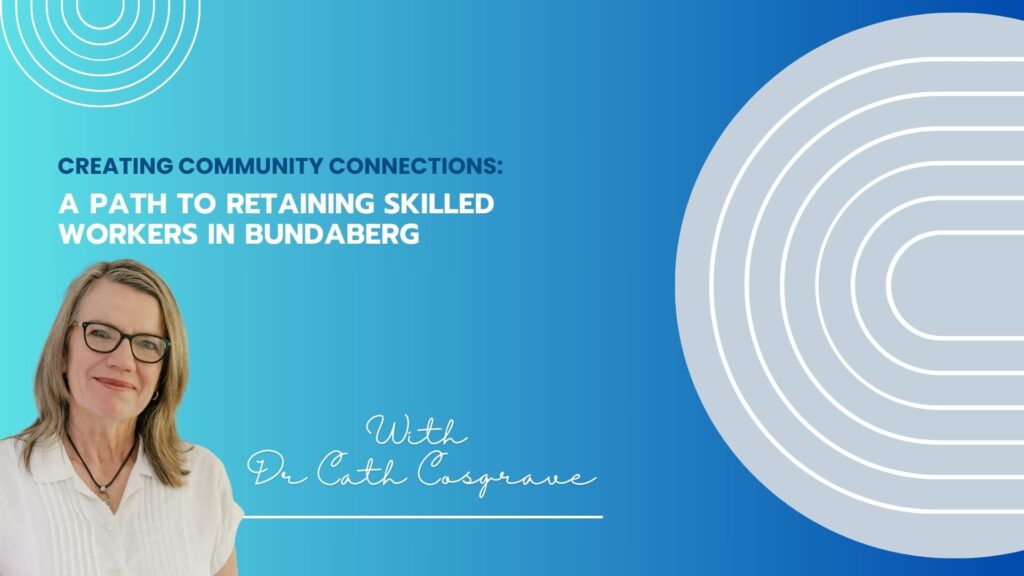
Creating Community Connections: A Path to Retaining Skilled Workers in Bundaberg
In today’s ever-evolving world, attracting and retaining skilled professionals in rural and regional communities is a challenge many towns face. Dr. Cath Cosgrave, an expert in rural workforce retention and attraction, shared valuable insights on this subject during a recent episode of the Partner Up podcast and web series by Welcome to Bundaberg. Hosted by Gayle Reynolds, the discussion highlighted strategies that can help communities like Bundaberg attract skilled workers and ensure they stay, focusing on the importance of a community-driven, inclusive approach.
Dr. Cosgrave’s expertise stems from over a decade of research, including a PhD that explored what drives skilled professionals to rural areas and, perhaps more importantly, what prompts them to leave. The study initially aimed to uncover why people stayed but evolved into understanding the reasons behind their departure. A key finding from her research revealed that while professional opportunities are critical, the social factors—such as community integration and support—play a significant role in whether newcomers choose to remain in a rural town.
At the heart of this approach is the concept of the Community Connector program, which has been gaining traction across Australia, including in Bundaberg. The program is designed to provide tailored support for newly arrived professionals and their families, addressing not only their professional needs but also the social aspects that are often overlooked. For instance, newcomers often face challenges like securing housing, finding suitable schools for their children, and accessing community services. By addressing these needs within the first three months, the program helps foster a sense of belonging, reducing the risk of newcomers feeling isolated and eventually leaving.
A notable success story comes from Glen Innes, New South Wales, where the Community Connector program helped secure the services of a much-needed GP and a pharmacist, both originally from Iraq. The community worked together to provide suitable housing and additional support, including childcare for their child with special needs. This collaborative effort not only addressed an immediate healthcare shortage but also demonstrated the power of a community-led approach in retaining skilled professionals.
The Community Connector model has proven adaptable across different sectors, including healthcare, engineering, and agriculture. It is especially relevant in regions like Bundaberg, where shortages of skilled workers can have ripple effects throughout the community. By actively involving local businesses, councils, and key community leaders, Bundaberg aims to create a welcoming environment that supports newcomers, ensuring they feel both professionally and socially integrated.
For Bundaberg, the journey to establishing a Community Connector program is already underway, with an emphasis on forming a steering group and engaging key stakeholders. Gayle Reynolds, reflecting on the local effort, noted, “We want to make sure that when we invest time, effort, and resources in bringing skilled professionals to Bundaberg, we hold onto them, offering long-term support that makes them feel truly at home.”
Dr. Cosgrave emphasised the importance of a person-centered, place-based approach. She described how each community should leverage its unique strengths while acknowledging and addressing challenges like housing and childcare availability. Her message is clear: community-driven solutions, informed by research and tailored to local needs, are the key to creating a sustainable, skilled workforce in rural areas.
In the podcast, the discussion also highlighted the importance of inclusivity. While many rural communities pride themselves on being welcoming, true inclusivity means actively involving newcomers in social activities and ensuring that they feel seen and valued. Dr. Cosgrave pointed out, “It’s not enough to be welcoming; communities need to be truly inclusive, making sure that every newcomer feels they belong.”
The Welcome to Bundaberg initiative is already playing a part in this process, offering resources like welcome bags, magazines, member website and app to help new arrivals navigate the local landscape. But as Bundaberg moves toward establishing its Community Connector program, the focus will expand to providing more personalised support, ensuring that newly arrived professionals and their families find their place in the community quickly and feel encouraged to stay.
Dr. Cosgrave’s insights offer a roadmap for Bundaberg and other rural communities facing similar challenges. The combination of research-backed strategies, local collaboration, and a deep commitment to making newcomers feel at home can transform the dynamics of workforce retention. As Bundaberg looks to its future, the Community Connector program could be the key to building a thriving, sustainable community where skilled professionals choose not just to work but to live and belong.
For more information on how the Community Connector program could benefit your community, visit Dr. Cath Cosgrave’s website, Attract Connect Stay, or follow her on LinkedIn for updates on similar initiatives across Australia.
Welcome to Bundaberg is seeking expressions of interest from passionate community leaders to join a newly formed Community Steering Group. This group will be responsible for developing a comprehensive, whole-of-community strategy focused on workforce attraction and retention in the Bundaberg region. Your leadership and insights will be instrumental in addressing the unique needs of our community and ensuring its sustainable future. If you are committed to making a lasting impact, we invite you to express your interest . Click Here to express your interest.
